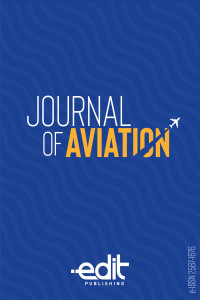Havayolu Sektöründe Elektronik Ağızdan Ağıza İletişime (eWOM) Yönelik Bir Derleme
eWOM, Havayolu, Ağızdan Ağıza İletişim, Çevrimiçi İletişim
A REVIEW ON ELECTRONIC WORD-OF-MOUTH (EWOM) IN AIRLINE SECTOR
eWOM, Airline, Word-of-Mouth, Online Communication,
___
- Akhehurst G (2009) User generated content: the use of blogs for tourism organisations and tourism consumers. Serv Bus 3:51–61.
- Akrimi, Yve Khemakhem, R. (2012). What drive consumers to spread the word in social media?. Journal of Marketing Research & Case Studies, 2012, 1.
- Alexandrov, Aliosha J. (2007). “Information Variability of Online Word-of-Mouth as a Context for Customer Decision Making”, University of Memphis (Yayımlanmış Doktora Tezi)
- Apăvăloaie, E. I. (2014). The impact of the internet on the business environment. Procedia Economics and finance, 15, 951-958.
- Baharun, R., Wahid, A., Sazreen, Hve Awang, Z. (2015). Mystery of Aircraft MH370: Electronic Word-of-Mouth Towards Malaysia Airline Reputation. Advanced Science Letters, 21(5), 1170-1172.
- Başkaya, H. C. (2010). Tüketcilerin Teknolojik Ürünlere Yönelik On-Line Fikir ve Değerlendirmelerinin (eWOM) Analizi. Uludağ Üniversitesi. Sosyal Bilimler Enstitüsü. İşletme Anabilim Dalı Üretim Yönetimi ve Pazarlama Bilim Dalı. (Yayımlanmış Yüksek Lisans Tezi).
- Beneke, J., Mill, J., Naidoo, Kve Wickham, B. (2015). The impact of willingness to engage in negative electronic word-of-mouth on brand attitude: a study of airline passengers in South Africa. Journal of Business and Retail Management Research, 9(2), 68-84.
- Bigné, E., Ruiz, C., Andreu, Lve Hernandez, B. (2015). The role of social motivations, ability, and opportunity in online know-how exchanges: evidence from the airline services industry. Service Business, 9(2), 209-232.
- Cheung, C. Mve Thadani, D. R. (2012). The impact of electronic word-of-mouth communication: A literature analysis and integrative model. Decision support systems, 54(1), 461-470.
- Chu, S. Cve Kim, Y. (2011). Determinants of consumer engagement in electronic word-of-mouth (eWOM) in social networking sites.International journal of Advertising, 30(1), 47-75.
- Hennig-Thurau, T., Gwinner, K. P., Walsh, G. ve Gremler, D. D. (2004). Electronic word-of-mouth via consumer-opinion platforms: what motivates consumers to articulate themselves on the internet?. Journal of interactive marketing, 18(1), 38-52.
- Lee, J ve Lee, J. N. (2009). Understanding the product information inference process in electronic word-of-mouth: An objectivity– subjectivity dichotomy perspective,‖ Information & Management. 46(5), 302-311.
- Lee, ] J., Park, D. H ve Han, I. (2008). The effect of negative online consumer reviews on product attitude: An information processing view,‖ Electronic Commerce Research and Applications, 7(3), 341-352.
- Katz, E ve Lazarsfeld, P.E. (1955) Personal Influence: The Part Played by People in the Flow of Mass Communications. Glencoe, IL: The Free Press.
- Kemp, S. (2017). “Digital in 2017 Global Overview.” https://wearesocial.com/special-reports/digital-in-2017-global-overview.
- Lerrthaitrakul, Wve Panjakajornsak, V. (2014). The impact of electronic word-of-mouth factors on consumers' buying decision-making processes in the low cost carriers: a conceptual framework. International Journal of Trade, Economics and Finance, 5(2), 142-146.
- Persson, S., Pettersson, Sve Thunberg, R. (2015). Är företagen maktlösta?: En studie om hur tjänsteverksamheter kan gynnas av eWOM. Lisans Tezi, Linnaeus University, School of Business and Economics.
- Sun, T., Youn, S., Wu, Gve Kuntaraporn, M. (2006). Online word‐of‐mouth (or mouse): An exploration of its antecedents and consequences. Journal of Computer‐Mediated Communication, 11(4), 1104-1127.
- Tseng, W. C. (2012). A Study of Online Word of Mouth of Service Quality in Airline Industry: A Case of Backpackers. com. Yayınlanmış Yüksek Lisans Tezi. National Taiwan University of Science and Technology. Yönetim Okulu
- Yayın Aralığı: Yılda 3 Sayı
- Başlangıç: 2017
- Yayıncı: Vedat Veli ÇAY
HAVALİMANI TERMİNAL BİNALARINDA ISI YALITIMI VE ISICAMIN ENERJİ PERFORMANSINA ETKİSİ
Mehmet Kadri AKYÜZ, Önder ALTUNTAŞ, Vedat Veli ÇAY
Dönüştürücü Lider Özellikleri Taşıyan Emniyet Liderleri: Kavramsal Bir Çerçeve
Havayolu Sektöründe Elektronik Ağızdan Ağıza İletişime (eWOM) Yönelik Bir Derleme
TURBOJET MOTORLAR İÇİN PERFORMANS DEĞERLENDİRME PARAMETRELERİ
